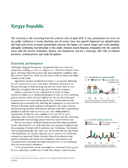ADB: Kyrgyzstan Outlook for 2012
The economy is still recovering from the political crisis of April 2010. A new government has been set up, public confidence is slowly returning, and all sectors have seen growth. Improved tax administration and high gold prices increased government revenue, but higher civil service wages and social spending, alongside continuing reconstruction in the south, strained overall finances. Integration into the customs union with the Russian Federation, Belarus, and Kazakhstan may be a challenge, with risks of inflation pressures, unemployment, and trade disruptions.
Following a sluggish first quarter, real growth picked up as the year progressed, reaching 5.7% for 2011. All sectors showed robust gains, reflecting improved security and sustained public confidence after the events of April 2010, which saw the ouster of the president and ethnic violence in the south.
Agriculture showed a modest bounce back to 2.3% growth, following its 2.6% contraction in 2010. Industry expanded by 8.8%, with growth in nearly all major subsectors. Manufacturing grew by 9.8%, or 18.8% excluding gold production, which declined slightly year on year due to low gold concentration in ore extracted during the year. Textile and chemical industries grew especially fast, reflecting the resumption of trade with the Russian Federation and Kazakhstan (disrupted by the crisis). The services sector, which fell sharply in 2010 following the political events, rebounded by 5.2%, reflecting improved consumer sentiment and the reopening of borders with Kazakhstan and Uzbekistan.
GDP growth is expected to slow to 5.0% in 2012 and then rise to 5.5% in 2013. With the restoration of public confidence and political stability, higher domestic demand and stronger investor confidence are expected to spur private sector activity in the non-gold sectors. Against this, the adverse impact of the eurozone recession on Kazakhstan and the Russian Federation—key trading partners and sources of worker remittances – will inhibit growth. Private transfers are expected to stay around 20-25% of GDP, however. Growth is expected to be driven by the industry and services sectors. Government plans to provide subsidized loans to farmers in 2012 are expected to promote growth in agriculture. Large investment projects in infrastructure will drive construction, such as rehabilitating major road networks and building new power grids. Many other projects, including additional power grids and hydropower plants, remain under negotiation.

